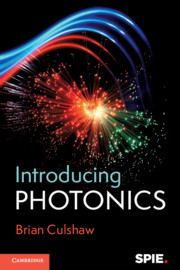3 - Light Interacting with Materials
Published online by Cambridge University Press: 21 July 2020
Summary
Chapter 3:describes the essential principles of light interacting with materials.This includes transmission in both isotropic and anisotropic media and all the material based phenomena which give colour into our lives.This colour also provides insights into the material themselves – spectroscopic signatures!Of course light can also be scattered – sunlight spreading through a room is an everyday example and absorbed through designing surface finishes – a black card heats up much more quickly than a white one when left in the sunshine.There are also materials which have externally controllable optical properties – perhaps liquid crystals are the most familiar example.The absorptive process can of course go backwards – we have light emitters.These range from the centuries old heated ‘black’ body to flame tests for particular materials (sodium – table salt – probably the most familiar) to the lasers. Fluorescent materials and LED’s which are increasing apparent in everyday life.
- Type
- Chapter
- Information
- Introducing Photonics , pp. 25 - 57Publisher: Cambridge University PressPrint publication year: 2020

